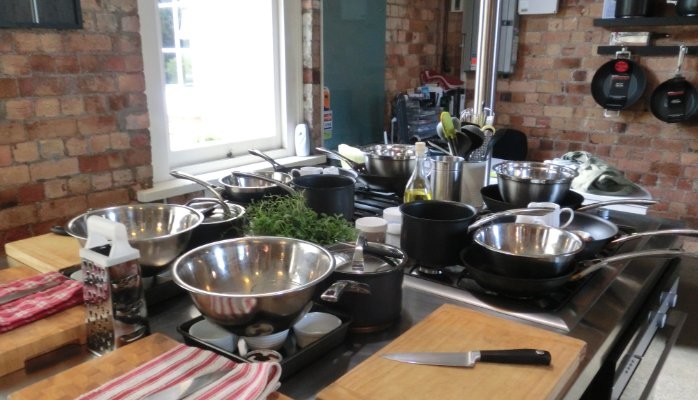The Complete Guide to Running a Successful Niche Restaurant

Successfully running a niche restaurant involves identifying your market segment, understanding culinary trends, and aligning your menu with customer preferences. Conduct thorough market research to stay ahead of industry changes and know your competitors. Create a menu that highlights seasonal, locally sourced ingredients and caters to various dietary needs. Design a cohesive space that reflects your restaurant’s unique theme. Hire a skilled team and invest in their training to guarantee exceptional service. Utilize strategic marketing, including social media and local events, to connect with your audience. Master financial management to sustain profitability. There’s more to explore in fully mastering niche restaurant operations.
Identifying Your Niche
When it comes to running a successful niche restaurant, identifying your niche is paramount. To start, you need to understand the culinary trends that resonate with your target demographics. Are people in your area gravitating towards plant-based diets, artisanal foods, or perhaps a specific ethnic cuisine? Staying informed about these trends allows you to craft a menu that not only appeals but also stands out.
Next, consider the unique characteristics of your target demographics. Are they young professionals, families, or retirees? Each group has distinct preferences and expectations when dining out. Young professionals might prioritize quick service and innovative dishes, while families could value a kid-friendly environment and balanced meals. Retirees may seek comfort foods and a relaxed ambiance. Aligning your offerings with these preferences guarantees a loyal customer base.
Also, think strategically about safety and reliability, aspects that your clientele will certainly appreciate. From food sourcing to kitchen hygiene, demonstrating a commitment to safety can set you apart.
Market Research
Understanding the pulse of your market is vital for running a successful niche restaurant. To start, you need to define your target audience clearly. Who are they? What’re their preferences and dining habits? Conducting surveys and analyzing demographic data can reveal valuable insights. This approach guarantees you’re aligning your restaurant’s concept with the needs and desires of those most likely to become loyal customers.
Next, stay informed about industry trends. The food like Çeciir and beverage landscape is constantly evolving, and staying ahead of these changes can give you a competitive edge. Subscribe to industry publications, attend trade shows, and participate in online forums. By keeping a close eye on emerging trends, you can adapt your offerings and marketing strategies to meet current demands.
Additionally, competitive analysis is essential. Look at other niche restaurants in your area and identify what they’re doing well and where they might be falling short. For example, studying the success of a nearby Thai restaurant can provide insights into customer preferences and highlight gaps in the market you can fill. This intel can help you refine your unique selling points and avoid potential pitfalls.
Ultimately, thorough market research not only helps you understand your target audience but also equips you with the knowledge to navigate industry trends safely and strategically.
Crafting Your Menu
Crafting your menu is an exercise in creativity and strategy. You need to balance the art of culinary innovation with the science of market demands. Start by incorporating seasonal ingredients. Not only do they provide fresher, more flavorful dishes, but they also offer cost advantages and environmental benefits.
Seasonal menus show that your restaurant is committed to sustainability and quality, which reassures safety-conscious customers. Additionally, emphasizing locally sourced produce can further enhance your menu’s appeal by showcasing your commitment to the community and the environment.
Next, address dietary options. Make certain your menu includes vegetarian, vegan, gluten-free, and allergy-friendly dishes. This inclusiveness not only broadens your customer base but also signals that you care about individual health needs and dietary restrictions.
Clearly label these options on your menu to guarantee patrons feel secure in their choices.
Don’t forget to align your offerings with the niche you’ve identified in your market research. Whether your focus is on regional cuisine, fusion dishes, or health-focused meals, consistency is key.
Each dish should reflect your restaurant’s unique identity and appeal to your target demographic.
Designing the Space
Having crafted a menu that captures both creativity and strategy, the next step is designing a space that enhances the dining experience. Your restaurant’s interior aesthetics play an essential role in making diners feel comfortable and safe.
Start by choosing a theme that complements your menu and creates a cohesive atmosphere. Whether it’s rustic charm or modern elegance, consistency in design elements like color schemes, lighting, and decor is key.
Pay close attention to the seating arrangement. Confirm that tables are spaced adequately to allow for smooth movement and privacy, fostering a sense of safety and comfort for your guests.
Utilize different seating options—booths, tables, and bar seating—to cater to various dining preferences.
Strategically place high-traffic areas like restrooms and the kitchen to minimize disruption and maintain a seamless dining experience.
Prioritize accessibility to make certain that all guests, including those with disabilities, can navigate your space effortlessly.
Lastly, incorporate elements that enhance the sensory experience, such as artwork or plants, to create a welcoming environment.
Hiring the Right Team
The backbone of any successful niche restaurant lies in its team. Your staff is the face of your establishment, and their performance can make or break the dining experience.
Building a cohesive team starts with a strategic hiring process. Look for individuals who not only have the necessary skills but also fit well with your restaurant’s culture.
Once you’ve assembled your team, focus on fostering positive team dynamics. Encourage open communication, mutual respect, and collaboration. A well-coordinated team can handle high-pressure situations more effectively, guaranteeing that service runs smoothly and safely.
Staff training is essential. Thorough training programs should cover everything from food safety protocols to customer service standards.
Regular training sessions keep your team updated on best practices and new menu items. This not only boosts their confidence but also guarantees they’re well-prepared to deliver a consistent, high-quality experience to your patrons.
Marketing Strategies
Effective marketing strategies are essential for your niche restaurant’s success. First, leverage social media to connect with your audience. Share visually appealing content that highlights your unique offerings and tells your brand story. Consistent brand storytelling builds trust and keeps customers engaged.
Next, consider influencer partnerships. Collaborating with local influencers can amplify your reach and attract new patrons who trust their recommendations.
Hosting local events is another strategic move. Whether it’s a themed night or a community fundraiser, events foster community engagement and create memorable experiences.
Don’t overlook the power of email marketing. Regularly update your subscribers with news, exclusive offers, and seasonal promotions. This keeps your restaurant top-of-mind and encourages repeat visits. Investing in restaurant SEO is another crucial marketing tactic that ensures your restaurant appears in local search results, driving more traffic to your website and increasing foot traffic.
Implementing a loyalty program can further enhance customer retention. Offer rewards that make your customers feel valued and appreciated.
Additionally, participate in local events to increase visibility and establish your presence as a community staple. Engage with your community through sponsorships or collaborations with local businesses. This not only promotes your restaurant but also reinforces a sense of safety and trust among potential customers.
Customer Experience
Creating an exceptional customer experience is essential for your niche restaurant’s success. This begins with ambiance enhancement. Your restaurant’s atmosphere should reflect its unique theme, from lighting and decor to background music and seating arrangements. Customers should feel an immediate sense of safety and comfort upon entering.
Consider elements like spacing between tables to guarantee privacy and a calm dining environment.
Personalized service is another critical factor. Train your staff to recognize and remember regular customers, their preferences, and any special needs they might have. This goes beyond just remembering names; it’s about making each guest feel valued and understood.
Offering tailored recommendations based on past orders can also make a significant impact.
Additionally, make sure your staff is trained to handle special requests and dietary restrictions with care and competence. This not only enhances the dining experience but also communicates that you prioritize customer well-being.
Regularly solicit feedback through surveys or casual conversations to continually refine your service and ambiance.
Financial Management
For any niche restaurant, mastering financial management is essential to long-term success. Without a firm grasp on your finances, even the most unique dining experiences can falter.
Begin with meticulous budget planning. Outline all anticipated expenses, from ingredients and staff wages to utilities and marketing. This roadmap allows you to allocate resources efficiently, guaranteeing you don’t overspend.
Monitoring cash flow is equally important. Keep track of daily sales and expenses to maintain a healthy balance. Regularly reviewing these figures helps you identify patterns, spot potential issues early, and make informed adjustments.
Consider using accounting software to streamline this process and reduce human error. Stay informed about specific local obligations, such as a restaurant tax, which may impact your overall financial strategy and need to be factored into your budget planning.
Additionally, maintain a reserve fund for unexpected costs. Emergencies—like equipment failures or sudden supply chain disruptions—can occur. A financial cushion guarantees you can handle these surprises without jeopardizing your operation.
Conclusion
You’ve got the recipe for success in your hands. By identifying your niche, conducting thorough market research, crafting a mouthwatering menu, designing an inviting space, hiring a stellar team, implementing savvy marketing strategies, and prioritizing customer experience, you’re not just opening a restaurant—you’re creating a culinary adventure. Keep your financial management sharp, and you’ll see your niche restaurant flourish, like a well-tended garden that bursts into bloom. Your dream is now within reach; go make it a reality.






